
48 minute read
Solar lamps light up Koomati tribals’ lives
from Rotary News December 2021
by Rotary News
V Muthukumaran
When forest ranger Manikandan briefed RC Salem Central (RID 2982) past president Sureshkumar about the plight of Koomati tribals in Valparai taluk, the club members did not have any clue about the daily hardships faced by this primitive community living at the Anamalai Tiger Reserve, a protected habitat for wild animals and endangered species. “Soon, we received a letter from the ranger detailing the pitiable conditions of 36 tribal families living in Komati settlement at the tiger reserve. The government has not provided power supply or concrete houses to them as they live in a protected wildlife zone,” says PDG R Vasu, ARRFC.
Advertisement
Following the letter, a four- member fact-finding team led by Vasu visited the tribal hamlet, 65km from Pollachi. “We interacted with them to shortlist their basic needs and know what can be done to make their life easier. Power supply and houses are prohibited in this wildlife habitat. Hence, we decided to install solar streetlights and solar lamps in their mud huts,” recalls Vasu. After the survey team went back, the club gave shape to its tribal upliftment project by working on the details.
A 2,000-litre water tank was installed and pipelines were laid
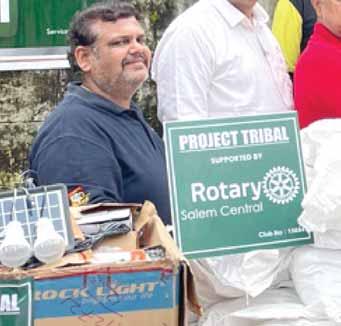

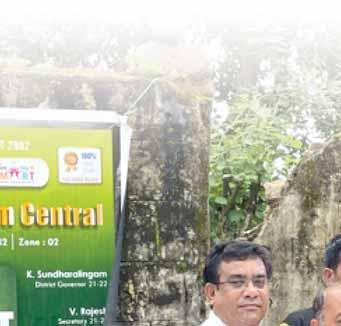
PDG R Vasu gives a bag of essentials to a tribal woman in the presence of (from L) district secretary Rajesh, DG K Sundaralingam and club president Tamil Mohan.
from the high mountains to draw water and provide the last mile connectivity to tribal huts so that they can have running water from the storage tank. “With 20 solar streetlights and a solar lamp at each hut, now they have adequate lighting and need no longer fear being attacked by tigers and other wild animals. These lights have removed darkness from their life,” smiles Vasu. But the tribals have to walk 12km to either Valparai or Topslip, a part of Anamalai mountain range and a wildlife sanctuary, to earn their livelihood by doing menial jobs. “There is no possibility of road transport as it is a dense forest with strict law enforcement.”
DG K Sundaralingam, along with 10 Rotarians including club president Tamil Mohan, secretary Rajesh, Vasu, PPs K Rajendran and Sureshkumar, visited Koomati and donated a range of essentials including 100 raincoats, two cooking vessels to each family, sleeping mats, bedsheets, grocery bags worth `1,000 each, and 100 vegetable seed packets. “We will be taking up minor repairs of the huts soon. But we can’t provide houses which are banned in this location,” says Vasu. The tribal upliftment project costing `3.5 lakh will be replicated in 16 more places with the support of RID 3203, at an estimated cost of `45 lakh. “The funding will be a mix of global grant and member contributions. We will complete this entire project before the next Rotary year.”
Thanksgiving Day All the 36 families sported happy faces and were beaming with joy at a thanksgiving meet hosted by the beneficiaries. “Now there is no darkness in our daily life. Our hut is clean, there is running water and we sleep on good mats,” said Mani (60), tribal chief. But their hardships are far from over. Each tribal gets a daily wage of `200 for three months a year and free rations from the government. “But their basic needs are not yet met and they continue to lead a very primitive life,” adds Vasu.
RC Hubli Vidyanagar, RID 3170, inspired by the Project Drishti of Rotary Club of Madras East (RCME), RID 3232, launched the project ‘The Eye Story’, under which the club donated Smart Vision Glasses (SVS) designed by Smart Health Global, a Bengaluru-based IT company, to 16 visually-impaired students. “RCME helped us get in touch with the manufacturers and guided us through the process. Each device costs `25,000. VRL Logistics, Hubli, is partnering with us as part of their CSR venture,” says club president, Mahima Mohit.
She hosted a zoom conference for the clubs in her district to interact with the CEO of Smart Health Global, Ramu Muthangi. “Many clubs
Smart vision spectacles for the visually-challenged in Hubli
Team Rotary News

DG Gaurish Dhond participates in the spectacles distribution to the visually-challanged, along with club president Mahima Mohit (third from L).
want to take up this project and DG Gaurish Dhond has placed an enquiry for bulk supply,” she added.
Elated by the feedback, RCME club president M Srinivasa Rao says, “we are glad that our project has become a catalyst to change the lives of the visually-impaired. I got lot of enquiries after the project was published in Rotary News.”
American good Samaritans help rural India with medical equipment
Team Rotary News

The BiPAP-CPAP machines being handed over to the Mayiladuthurai GH through RC Mayiladuthurai Pride.

During the Covid pandemic, the Rotary Club of Silicon Valley for Global Impact and Indian Covid SOS, a voluntary organisation in the US comprising scientists, clinicians, engineers, policy makers, etc, came together to collect money and send medical equipment known as BiPAP/ CPAP, a kind of a simple ventilator, for use by primary health centres in remote and rural parts of India.
RID 2981 IPDG Balaji Babu explained that each of these machines costs around `70,000 and comes in two parts, which are detachable. This machine is also a kind of non-invasive, and a more basic form of a ventilator, and has been donated by the Rotarians and other philantrophists in the US, with the objective of bringing relief to patients in remote and rural PHCs, which lack adequate medical equipment.
According to information available on the Net, BiPAP is primarily used to treat heart, lung and neurological disorders that require structured airway support during sleep. Both CPAP and BiPAP machines are available with a range of accessories. “It was decided to give these machines to rural areas where they are required not only for Covid-related but
other ailments as well, particularly suffered by children,” says Balaji.
It’s an ongoing project and already 126 machines have been received and donated to rural areas. He adds that PDG Ramesh Hariharan, from RC Silicon Valley Global Impact, who had earlier worked with him for doing a project in Karaikal, and hails from Palakkad in Kerala, got in touch with him through a zoom meeting. He had coordinated the raising of funds, getting the machines and sending them to India, through a joint initiative titled Volunteers from United States of America and India (VUAI). While some machines have been given to rural areas near Chandigarh, Bengaluru and Hyderabad, three machines have been given to GH, Mayiladuthrai, Tamil Nadu, in July 2021, and others have been given to several remote PHCs in RID 2981, including the hilly areas close to Kodaikanal, Ootacamund, etc.
This medical equipment has been donated by the Rotarians and other philanthropists in the US, with the objective of bringing relief to patients in remote and rural PHCs in India, which lack adequate facilities.
A training programme on global grant for Literacy
Kiran Zehra

To educate Rotarians on how to get approval for global grant for basic education and literacy (BEL) projects, the Rotary Action Group – BEL of RID 3232 conducted a month-long online training programme, Project Vidyarthi – Local and Global. “Many Rotarians think that literacy projects are about buying notebooks, stationery, or classroom furniture. But there is so much more to literacy. You could teach through yoga or by singing. Vidyarthi will help Rotarians access resources from across the world to understand and plan holistic literacy projects” says Vasanthi Ranganathan, who audits BEL projects as a cadre member. She cited RC Johannesburg, RID 9400, that had implemented a GG project on nutrition to increase cognitive ability in students. “While the scalability and outcome of the project matter, Rotarians must also understand how their project will be monitored and evaluated.”
Open to Rotarians and non–Rotarians, the 30-day and 90 hours programme included sessions on various BEL projects that highlighted their key features through dance, music, relationships, communication, religion and values which helped to design wholesome learning initiatives.
The online programme raised `7,700 through the sale of Vidyarthi mugs, a special memento, which will be displayed at the literacy projects of RCs Chennai, Mambalam and Ambattur. DG J Sridhar announced a Vidyarthi Endowment fund of $25,000 to be used for literacy projects in the district. The event had 115 speakers and all the 60 sessions were uploaded on YouTube.
In his message, RI President Shekhar Mehta said that such training programmes should be held frequently, and not just in September (BEL month) as this will help Rotarians and clubs to understand and plan literacy projects holistically.
A medical college for aspiring doctors in NE India
Deepali Borthakur and Shilpi Sudha Goswami
Hope lies in dreams, he believed and with a spectacular dream, he created one of the best private state universities in northeastern India: the Assam down town University (AdtU). This is Rtn Dr Narendra Nath Dutta, a past district governor from RID 3240, founder-chancellor of AdtU and CMD of the Downtown Hospital. Coming from a small village, he achieved academic brilliance, getting an MBBS from Guwahati Medical College and post-graduation (ENT) from AIIMS, New Delhi. He went for higher studies in microsurgery in the UK.
After 14 years of teaching in GMCH, he resigned from there and started the down town hospital, the first NABH-accredited hospital in northeast India where 27 retired medical college teachers worked as consultants in the initial stage, giving a big thrust to the hospital.
He joined Rotary in 1974 and served as district governor in 1995–96. He received the Distinguished Service Award in 2013–14. He visited Kenya as a Rotary volunteer microsurgeon under an RI programme and stayed there for a month. He also brought a Rotary volunteer, Ecard Muller from South Africa to study the erosion problem in Majuli — the largest river island in the world, and presented a report. He and his wife Bandana are members of RC Guwahati.
He established the AdtU in 2010. Although there are various courses and programmes, the strength of this varsity is its Department of Nursing, Paramedical and MBA in Health Care.
The university enrols 240 students in various nursing programmes every year with 100 per cent placement. There are 19 paramedical courses with doctors as part of the faculty updating the students with the latest in this medical field.
Set up on an 80-acre land spread over the foothills on the banks of Bhramaputra river, at Panikhaiti, 16km away from Guwahati, the AdtU is one of the top medical institutions in the northeast offering students a unique blend of professional and academic excellence. The green campus is dotted with 10,000 trees of rare varieties including 1,000 orchids, 100 neem trees, 100 coconut, areca nut, walnut trees, ginger, haldi, lemon garden and many more.
The university has a solar power plant, rainwater harvesting system in four blocks and a 5,000-seatamphitheatre hosts various techno events, competitions, DJ Nights, and special performances.The AdtU has always encouraged the involvement of women in varsity affairs.
During her visit Union minister for women and child development Smriti Irani was pleasantly surprised to note that women faculty and students outnumbered men, and they outshine their counterparts in academics.
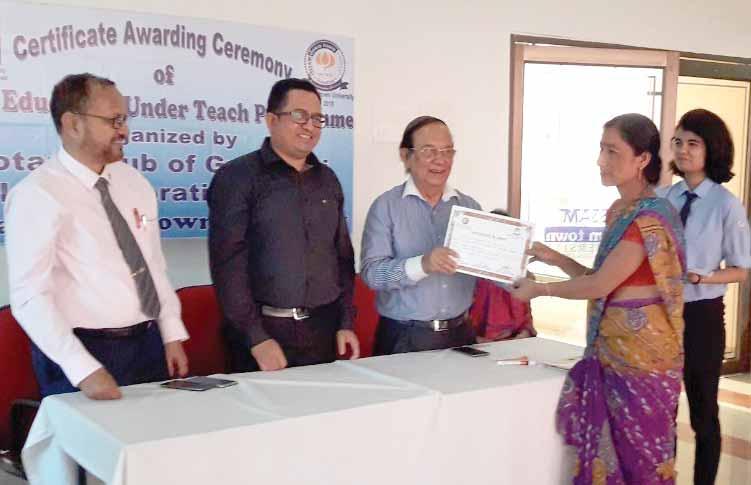
PDG Narendra Nath Dutta gives a functional literacy completion certificate to an adult learner at a programme organised by RC Guwahati.
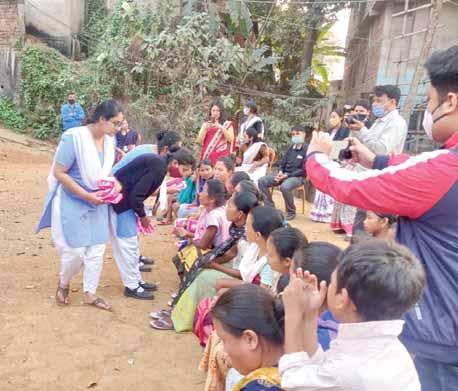
University students provide sanitary napkins to women.
The five hostels accommodate 600 girls and 300 boys. Facilities like indoor swimming pool, basketball ground, four badminton courts, yoga centre, gymnasium and football ground etc are available for students and faculties.
The AdtU is doing adult literacy programmes in association with RC Guwahati, in six surrounding villages under the Unnat Bharat Abhiyan. The students organise life skill, physical and mental health workshops for the villagers..
Each year over 2,500 students get enrolled in the varsity and till date, 2,000 have passed out of both UG and PG medical courses at the AdtU. I invite Rotarians to come and visit our campus. The dream of PDG Narendra Nath Dutta to build an eco-friendly university has helped the common people in Assam and other far-flung areas to realise their dream of becoming doctors and paramedics through quality education at the AdtU.
The writers teach English at the Assam down town University
2022 Houston Convention
Unconventional Houston
Miyoki Walker

While visiting Houston for the 2022 RI Convention June 4–8, set aside some time to discover what makes the city unique — one might even say quirky.
Houston has been called the art car capital of the world. No idea what that means? Check out the Art Car Museum, which showcases factory-made cars that have been elaborately transformed into creative pieces. This museum gives space to a type of subversive art that has historically been excluded from fine art institutions, while shedding light on the places where the personal, political and cultural meet. It’s also a lot of fun.
To see an extreme example of one person’s vision come to life, visit the Orange Show in Houston’s East End. Inspired by his love for oranges and good nutrition, postal worker Jeff McKissack’s 3,000-squarefoot handmade attraction features colourful structures, including a pond, stage, museum, wishing well and gift shop. It has been called one of the most significant folk art installations in the United States.
Another notable Houston oddity is the famous Beer Can House. In 1968, railroad worker John Milkovisch began a project that combined his creativity with his profound affinity for beer. He decorated his home’s exterior with flattened beer cans to create a stunning, functional work of art. Ripley’s Believe It or Not! estimates that the house incorporates more than 50,000 beer cans, which have been turned into curtains, walls, whirligigs, and more. Now that’s what we call inventive recycling.
Learn more and register at
convention.rotary.org.
Rotary houses for sightless families in Madurai
V Muthukumaran
For the 49 visually-impaired families at Sakkimangalam village near Madurai in Tamil Nadu, Rtn SL Setumadava is god in human form. This good Samaritan from RC Madurai Star, RID 3000, has been providing all the basic necessities and utilities for the deprived families, whose breadwinners or all the members are sightless. “They came with an unusual request for residential houses in 2004; though an uphill task, I took it up as a challenge,” recalls Setumadava, the primary contact of Lowcost Shelter project. Till then, they were living in thatched houses and were exposed to external dangers.
He made several visits to the district collectorate for two years taking up the cause of these “marginalised families living on the edge of society which turns a blind eye to these sightless families,” he says. Free pattas (land title) were handed over to the beneficiaries in August 2006 by the then TN rural development minister MK Stalin, now CM, much to the relief of Setumadava and his team.
A daunting task But then the real challenge has just begun. With the mobilisation of resources and funds, they were able to complete 30 houses costing `63 lakh
Tamilnadu minister for commercial taxes P Moorthy hands over the house key to a beneficiary in the presence of Madurai district collector Aneesh Sekhar (R), club president L Srinivasan (3rd from L) and project coordinator SL Setumadava (2nd from L).

in four phases from May 2009 to Dec 2016. The club sought the help of PDG P Gopalakrishnan from Karur to expedite the construction of remaining houses “as it is getting delayed for various reasons. With his guidance, we got a global grant of $120,000 (approx 87 lakh) that helped us to build another 15 houses at the project site,” explains Setumadava. Rotary Club of The Hills-Kellyville, RID 9685, Australia, is their global partner. All the 15 houses were bigger in size compared to the 30 houses built earlier as “the Australian PDG was very particular that visually-impaired couples must get a separate room,” he smiles.
Two houses share a common wall in these low-cost shelters which have carpet areas of 185–240 sqft. “So far, we had spent `1.5 crore for 15 houses. We will take up the construction of remaining four houses.” TN minister P Moorthy was surprised that “Rotary has done a job that is primarily the responsibility of the government.” He volunteered to donate `5 lakh for the construction of one of the remaining houses. District collector Aneesh Sekhar assured that roads, water and power connections will be given to the new houses at the earliest.
PDGs S Gopal, DRFC and PDG A Purushothaman felicitated the project team. One of the beneficiaries, Thai Poosam (60) was emotional while receiving the house key. “But for Ayyah (Sir in Tamil, with due respect to Setumadava), we would not have got this beautiful house, which is beyond our ability. He is our father,” he says. Christened Rotary Bright Homes, the low-cost houses have truly brought ‘light’ in the life of the visually-impaired families at this Madurai village.
Nashik expo facilitates microcredit
Athree-day exhibition titled Rotary Goda Haat was organised to empower women from underprivileged families and tribal communities by RC Nasik Godavari, RID 3030, through microcredit.
The purpose of the expo was to display and sell products made by women from lower income families. “Also, the event gave confidence to them to face the market conditions and manage their business professionally,” said Rajesh Singhal, club president. All the 30 stalls displayed a range of homemade products such as spices, eatables, pooja items, women’s accessories, clothes, a rice variety grown by tribals, handmade envelopes, files, eco-friendly sanitary napkins and carry bags. “While some stalls were let out free of cost, rest were given with small charges to raise microcredit funds for 100 women,” he said.
The club’s microcredit initiative has already reached out to 40
Team Rotary News

DG Ramesh Meher and DGN Asha Venugopal (to the left of DG Meher) at one of the stalls at the expo.
women in three months, and it will further benefit 60 others in the coming months. The expo attracted 4,000 people and most of the visitors bought material from the stalls which spread happiness on the faces of beneficiaries. DG Ramesh Meher and DGN Asha Venugopal were felicitated by project leaders Dr Meenal Palod and Surekha Mahale.
GPS art to create Polio awareness
Kiran Zehra
Members of RC Guindy, RID 3232, in association with the Cycling Fellowship of Rotarians from Chennai, rode 16km across Chennai to create a GPS imprint with the message End Polio Now. GPS art involves recording the location with Global Positioning System (GPS) while cycling, walking, riding a bike or driving a car, and drawing pictures or messages on the tracks. The GPS Art Project was flagged off by DG J Sridhar.
Using the Strava app a route was created to complete the GPS art. Twenty-five cyclists rode in a single file for 12 hours to attempt an entry into the India Book of Records which is now in the evaluation stage. Naresh Kumar KN, the lead cyclist and a club member says, “The city of Chennai was our canvas, our movements, the paint, and our cycles made the brush strokes perfectly.” It may not be art in the conventional sense “but we rode the 16km to trace the GPS paths and sketch out End Polio Now.”
The most challenging part, he points out, was the planning. “Unlike cities like San Francisco where the streets are planned block by block, Chennai does not have grids and sectors that are convenient for cyclists.” After 20 hours of planning and ensuring that it did not hit a dead-end, the route was finalised. “Riding in one’s home city has a certain magic,” he says. “You discover different places, and areas you’d never had the chance to see.”
Another challenge was the weather. “It was a rainy day, but the enthusiasm the cyclists, both Rotarians and non-Rotarians, showed was great,” says Kumar.

Below:Cyclists at the finishing point.

Correcting clubfoot in Malda
Jaishree

Dr Debajyoti Das with his young patients and their mothers.
Eight hundred-odd children in Malda can walk normally and enjoy better social life, thanks to Dr Debajyoti Das, a member of RC Mango City Malda, RID 3240. Das is an orthopaedic surgeon and has been passionate about treating children with clubfoot ever since he started practising in the 1980s. Clubfoot is a congenital disorder where one or both feet are twisted downward and inward, making them look like golf clubs. “In earlier days people hesitated to treat this congenital disorder owing to superstitious beliefs, religious myths and illiteracy, and the children grew up into physically-challenged adults. This condition can easily be corrected if treated early,” he says.
Even as he was treating some children, “which required a lot of convincing the family”, he thought that it would be easier if he could get some support for advocacy and “that’s how I joined Rotary in 2011.” Since then, the club has been regularly organising 4–5 clubfoot detection and treatment camps every year and he began treating children in his clinic without consultation charges. The club sponsors the consumables required including splints. “The procedure is expensive and a burden on cash-strapped families. So they consider it a boon when my club helps them give their children dignity,” says Das. Special awareness programmes on club foot correction are included during PolioPlus National Immunisation Days to encourage parents to bring their child for treatment.
The correction process is lengthy and extends to 3–5 years. It involves applying a toe-to-groin PoP cast on the leg with clubfoot after gently manipulating the ligaments and tendons. After a few weeks splints are put in place to slowly bring the feet to position and to prevent relapse. As the child grows, the foot/feet also grow and the splints need replacement every three months, for up to four years, depending on the severity. “It is always better to start treatment when the child is as young as even a week-old as the bones will be flexible. For children beyond one year of age, surgery may have to be done under general anaesthesia. Local anaesthesia cannot be used as the child is too small to remain still,” says Das. Once the correction is done, these children can walk normally.
Follow up is done meticulously to ensure that the splints are changed in time, and special camps are organised to take care of the details.
Not all Rotary is the same
Insa Fölster

Rotarians worldwide are united under the umbrella of Rotary International. But what is the subtle difference? Rotarians from seven regions of the world talk about what Rotary culture means to them locally.

The new face of Rotary ‘Down Under’
Rotary in Australia is like the country itself — big and diverse. Australia is the world’s most successful multicultural society. Nearly half of today’s population was either born overseas or has at least one foreign-born parent. Most Australian Rotary clubs have also enthusiastically adopted RI’s policies on diversity, equality and inclusion, and welcome the many diverse people into their communities.
While Australia’s oldest clubs, celebrating their 100th anniversary this year, might still be considered elitist — affluent and sticking to traditional lunch meetings with a traditional format — clubs from small rural towns to coastal communities gather in a variety of different forms.
As part of the centenary of Rotary in Australia and New Zealand members of the Gold Coast Passport Rotary Club organised a walk to spread awareness about domestic violence.
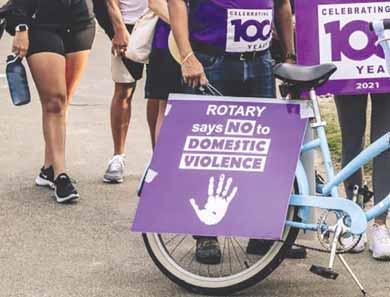



In Queensland’s capital, Brisbane, RC Woolloongabba is the first RC in the world to sponsor a Pride club in support of the state’s LGBTIQ community. For several years, the club has supported LGBTIQ organisations such as the Queensland Council for LGBTI Health and Open Doors Youth Service. Last year, the club members formed the first Rotaract Pride Club — a first for RI.
District 9640 is the top performing district in membership growth and retention in Zone 8 and has redefined the boundaries of club development. Then DG Andy Rajapakse and his team chartered five new Rotary clubs, two Rotary satellite clubs, three Rotaract clubs, one Interact club and one Rotex club. “We added a record 383 new members to our 58 Rotary clubs in 365 days,” he said, adding that 63 per cent of them were women and 24 per cent were under 40. “The Gold Coast Passport Rotary Club and the Gold Coast Corporate Rotary Club are among the best innovations in the district.”
Nationally, in celebration of Rotary’s 100th anniversary ‘down under’ (Australia, New Zealand and Southwest Pacific), clubs and districts from across the zone have joined together to support Rotary100downunder, Rotary gives every child a future.
The project celebrates 100 years of service and, in partnership with UNICEF, will vaccinate 100,000 children in nine South Pacific Island countries against rotavirus, pneumococcal disease and cervical cancer over three years. Both organisations will work with local governments to develop and implement immunisation programmes that administer the vaccines.
Although there are many centenary projects across the zone this year, Rotary gives every child a future is the project that involves all of Australasia and shows that Rotary remains strong in today’s world.



Meagan Martin (Gold Coast Passport Rotary Club) has been editor of Rotary Down Under since 2019
Service as a way of life
If Rotary’s motto is ‘Unity in Diversity’, what better example could there be than Rotary in a country as diverse as India? In a country with 22 major languages and several thousand dialects, Rotary’s language remains one — that of selfless service.
Rotary Club of Queen’s Necklace is a club in India’s financial capital, Mumbai. Members come from a wide cross-section of professions and
RC Woolloongabba is the first RC in the world
to sponsor a Pride club in support of the state’s LGBTIQ community.
businesses. There are a healthy number of women in the 181-member club. And ages range from 40 to 70. Efforts are constantly being made to attract younger members.
Social initiatives and the community form the culture that binds the club. With generous donations from members, the club is able to undertake very large projects. A typical fundraising appeal on Whatsapp collects pledges of $50,000 within a few hours. Last year, during the first wave of the pandemic, the club carried out a project worth almost $2 million to distribute 10 million meals to the hungry and homeless severely affected due to the long lockdown of the country. Half of these funds were donated by members, their families and friends. Members are passionate about helping the local community in the areas of education, the underprivileged, subsidised health facilities for the poor, and improving living conditions for the rural population.
Camaraderie is a very important feature. Members came together every month for two meetings and at least one community event before the pandemic. All Indian festivals, and there are several, are usually celebrated with great joy each year. During Diwali the entire club comes together for a gala night. Due to the ongoing pandemic, no physical meetings are held, but zoom meetings are well-attended to listen to speakers from around the world. Members have also held virtual events, such as an illusion show, a
talent show and workshops. Indians are big foodies. So every month, delicious food baskets made their way to the homes of all members.
Sneha Pathak, member of RC Queen’s Necklace, Mumbai
One in 300 Norwegians a Rotarian
Six years before former chancellor and Hapag boss Wilhelm Cuno founded RC Hamburg, the first Rotary club in the German Empire, the first club in Scandinavia had already been founded on October 13, 1921. Olaf M Oleson, a Norwegian-American senator from Idaho and a member of RC Fort Dodge, had attended the RI convention in Edinburgh in June 1921, then visited the country of his birth and told his nephew there about Rotary. Ola Five, a captain in the Royal Guard, gathered eight friends and with them formed RC Kristiania. In 1924, like the city, the club changed its name and has since been called Oslo Rotary Klubb. Honorary members include Crown Prince Haakon Magnus, and his father King Harald V is honorary governor of Norway’s seven Rotary districts. The Oslo Rotary Klubb has not only founded 19 clubs in Norway, it also stood godfather with the København Rotary Klubb at the cradle of the Stockholm Rotary Klubb. Today, Norway is one of the strongholds of Rotary, with 335 clubs and around 14,000 members — one in 300 Norwegians is a Rotarian.
The clubs open their meetings with a ‘gladmelding’, a personal glad tidings. Meanwhile, a member goes from table to table selling raffle tickets; the winner wins a wine, the winning ticket is drawn by the speaker of the day. Proceeds benefit the club’s treasury. A member comments on a current topic in a three-minute talk, before a cold ‘lunsj’ is served at lunch meetings and a warm ‘middag’ in the evening.
Thanks to the excellent digital infrastructure, the clubs implement a variety of web-based initiatives. One of them is the ‘digital melting pot’; in regular network meetings, the clubs coordinate existing and planned projects with each other on a regional and national level, pooling resources and thus increasing the benefits of Rotarian project work. RC Færder focuses on academic youth: It offers free membership to its returning exchange students. Bjørn Rismyhr (RC KarmøyVest) had his Mercedes fitted with the vanity plate ‘Rotary’. “Rotary, is that a dance club?” was one of the questions he heard. “Whatever people ask, it’s a good opportunity to introduce Rotary,” Rismyhr says.
Kai-Axel Aanderud (RC HamburgDeichtor) is the son of a Norwegian

David King, a past president of RC Colchester from Essex, England, hands over Easter eggs — a pandemic distance away — to Sarah Raven-Lloyd of the Rainbow Trust, a charity that supports families of seriously ill children.

Members of RC Queen’s Necklace, Mumbai, distributed food packages to rural women during the pandemic.
father and a German mother. He won Uranienborg Rotary Klubb (Oslo) as a partner club of his RC Hamburg-Deichtor
Inequality and many needs
There are three districts (9350, 9370 and 9400) that span South Africa and geographically include six neighbouring countries, Angola, Botswana, the Kingdom of Eswatini, Lesotho, Southern Mozambique and Namibia. Attending a city club can be very different from attending a rural club. Members of city clubs have traditionally been industry executives and more formal. Rural clubs have historically attracted mostly medium and small business members who are very social and less formal. However, both forms of clubs are constantly changing as they strive for diversity and gender equality. Women were not admitted to Rotary until 1991, but now the region boasts of a 32 per cent women-Rotarian membership.
Most clubs in Southern Africa are based on the historic, traditional club model. The concept and flexibility of e-clubs and satellite clubs are slowly gaining traction.
There is so much inequality and poverty, and so the needs are plenty. I can safely say that all seven focus areas are very relevant to Southern Africa. If I were forced to prioritise the needs, I would list the following areas in order of importance: water and sanitation, malnutrition and early childhood development, economic opportunity, peace and conflict prevention. The region is very receptive to inter-country committee agreements. To date, there are good relationships with districts in Germany, Canada, India and the UK. These relationships are established not only for projects but also for friendship exchanges, youth exchanges, cultural exchanges, conferences or webinars.
Grant Daly is past governor of District 9400
Much less traditional than in Germany
In the past, Great Britain has always behaved like an unruly teenager — proud, but stubborn and very independent. After all, we are an island nation, only 20 miles from mainland Europe at its narrowest point. Yet in the context of Rotary in Great Britain and Ireland, the nations of England, Scotland, Wales, Northern Ireland and the Republic of Ireland are five countries and two very different islands in terms of their characteristics and cultures. Yet we are all connected by the common bond of Rotary. There are about 40,000
Rotarians in Great Britain and Ireland, reflecting a steady decline in membership in recent decades. Of those, 22 per cent are women, and the average age is 71. But these are not typical times. Covid-19 has changed the shape and nature of Rotary worldwide. With clubs meeting online, fundraising opportunities are extremely limited.
Some 12.4 million Britons volunteered in their communities during the pandemic, joined by tens of thousands in the Republic of Ireland. The post-pandemic challenge will be to welcome these future Rotarians into our clubs now that they have a taste for volunteering.
Over the past 16 months, Rotary clubs have been working in their communities to help the needy and isolated shop for and pick up medicine. They have supported food banks that exist in unbearable conditions due to rising unemployment. Clubs have worked together in teams to provide personal protective equipment such as gowns and face masks for frontline workers — many of whom are Rotarians themselves.
This desire to volunteer and get involved in the community was evident last May when Rotary was at the forefront of the UK Volunteer Expo, a two-day digital showcase of achievement. More than 5,500 people registered for the Expo — 40 percent of them Rotarians — and learned how the whole nature and shape of volunteering is changing. The message of the Volunteer Expo was that we need to make volunteering more relevant to the next generation by providing opportunities that are compatible for younger people with their busy work lives. We need to be more flexible, and that includes the way we do Rotary.
Rotary in these islands is much less traditional than in Germany. This flexibility has led to the development of satellite clubs, passport clubs, and clubs that no longer meet formally for dinner, but perhaps at a café on Sunday morning with children in tow.

Dave King (RC of Gosport in Hampshire, England) has been editor of the Rotary magazine for Great Britain and Ireland for four years. He has been a Rotarian since 2010 and has been a member of several clubs
Tradition-conscious and always on time
Rotary Japan has 88,310 members in 2,237 clubs in 34 districts (April 2021). Of these, 6,265 members are women, about seven per cent. The reason for the low number may be that there are few woman leaders in Japan. Japanese Rotarians tend to be executives or managers. The average age is 60. And once they join Rotary, few leave. Many have a long Rotary history.
Many clubs hold a regular onehour meeting where they have lunch and listen to a table talk. And typically Japanese, members are always very punctual! They consider fellowship important, so they sometimes hold evening meetings where they have more time.
In general, Japanese members are good at keeping traditions, but they are not good at changing or they are satisfied with the current situation. They understand the need to increase membership, but it is more important for them to include someone who understands the philosophy and fellowship of Rotary than to just increase membership.
RC Yokohama (about 200 members) holds regular meetings at a prestigious hotel. Before Covid-19, members met at the round table and enjoyed a meal at the hotel. Now they hold their meetings school style to avoid infection and without a meal. Box lunches are distributed after the regular meeting.
One of the projects we are doing in Japan is the Yoneyama Memorial Scholarship. Yoneyama is the name of the person who introduced Rotary to Japan. This project is funded by all Japanese Rotarians and awards scholarships to 900 foreign students studying in Japan each year. The goal is to develop excellent international

A child being given polio drops by Rotarians in Brazil.
students who will play an active role in the international community in the future and form a bridge between their home countries and Japan. To date, we have supported approximately 22,000 students from 129 countries and territories around the world. For regional reasons, most of them are Asian students, but 44 German students have also been supported so far.
Kyoko Nozaki has been editor of the Japanese Rotary magazine Rotary no Tomo since 2016
Lone leader in polio initiatives
The history of Rotary in Brazil began in 1923 with the founding of RC Rio de Janeiro. Today, there are 2,426 Rotary clubs and 51,945 Rotarians in the country of 31 Rotary districts. Since then, Brazil has hosted three RI conventions: in Rio de Janeiro (1948) and São Paulo (1981 and 2015). RI has had three Brazilian presidents: Armando de Arruda Pereira (1940/41), Ernesto Imbassahy de Mello (1975/76), and Paulo Viriato Corrêa da Costa (1990/91), whose Preserve Planet Earth programme inspired the creation of the new Foundation focus on the environment.
Reflecting Brazil’s territorial expanse and diverse economic, social and cultural characteristics, the country’s clubs have a wide variety of profiles: business people, freelancers, teachers and retirees.
Membership is increasingly growing with the number of women, who now make up about 30 per cent of Brazilian Rotarians. One of the hallmarks of Rotary in Brazil is its youth clubs, with 754 Rotaract clubs and 649 Interact clubs, which have 9,029 and 16,120 members, respectively.
The Rotary family in Brazil is developing important initiatives that help Brazilian communities overcome the stark social inequalities that still characterise the country. Many of these projects, including those funded through global grants, focus on disease prevention and treatment.
The fight against polio is a special chapter in this story. Since the 1980s, Rotary has been a partner with the Brazilian Ministry of Health in the fight against polio. Past donations have included funds to purchase vaccines. The last polio case in Brazil occurred in 1989, but Rotarians continue to volunteer at the annual National Immunisation Days. This commitment is reflected in World Polio Days (WPD), hosted by RI. Since 2016, Brazil has led the global ranking of WPD initiatives.
Nuno Virgílio Neto (honorary member, RC Rio de Janeiro) is a journalist and editor of Rotary Brasil magazine since 2016
(Reproduced from Rotary Magazin, Germany)
On a culinary trail of Indian regional food

Sharmila Chand
Diners are lapping up local flavours and regional tastes and chefs are embracing the trend as Indian regional dishes find a pride of place in the menus of popular fine-dining restaurants. Savouring traditional dishes of various regions of the country is a celebration of culture, history and heritage. Enjoy an array of flavours from Kashmir to Awadh, Maharashtra, Rajasthan and Rampur as chefs share their recipes for easy cooking at home.

Nalli Nihari

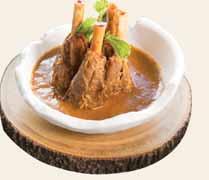
Rajesh Wadhwa
Executive chef Taj Palace, New Delhi
This rich indulgent preparation finds its origins in Shahjahanabad, which we call Old Delhi today and was developed during the reign of the Mughals. The dish is central to the cuisines of Bhopal, Awadh and Hyderabad and our recipe is a classic version with luscious velvety texture and is best enjoyed with khameeri roti or any steaming hot naan.
Ingredients
1 kg goat shanks 1.5–2 lt mutton stock 150 ml mustard oil 3 gm cloves 3 gm green cardamom 2 nos bay leaf 5 gm cinnamon 150 gm sliced onion 40 gm ginger paste 40 gm garlic paste 10 gm red chilli powder 20 gm yellow chilli powder 20 gm turmeric powder 50 gm coriander powder 150 gm yoghurt 50 gm roasted gram flour 20 gm garam masala powder salt to taste saffron few strands fresh coriander leaves and ginger juliennes to garnish
Method
In a heavy-bottomed pan, heat mustard oil. Add the whole spices and allow them to crackle. Add the sliced onions and cook until golden brown.
Add the ginger and garlic pastes. Sauté well. Add goat shanks along with red chilli powder, yellow chilli powder, turmeric, coriander powder, beaten yogurt and sauté well. Now add mutton stock and simmer on slow heat till the shanks are tender. In a separate pan, heat ghee, add roasted gram flour and sauté till aromatic and light golden in colour. Add this mixture to the prepared shanks and adjust the consistency of the gravy till nice and creamy. Adjust seasoning. Finish with garam masala and saffron. Garnish with fresh coriander leaves and ginger juliennes. Serve hot.
Macchi Koliwada
Swapnadeep Mukherjee
Executive chef, The Metropolitan Hotel & Spa
Macchi Koliwada is one of the most iconic dishes of Mumbai. The dish was originated by Punjabi migrants from the town Hazara (Pakistan) who settled with the Koli community of

Maharashtra. Hence you find this very similar to North Indian famous dish ‘Macchi Amritsari’. This recipe is quick, easy to make, flavourful with lots of scope for experimentation.

Ingredients
150 gm basa fillet 50 gm besan 30 gm rice flour 5 gm chilli paste 2 gm ajwain seeds 10 gm curd 5 gm degimirch 5 gm cumin powder 5 gm garam masala 5 gm turmeric powder 2 gm fennel seeds 1 pc lemon 10 gm ginger garlic paste 2 gm salt 500 ml oil to fry
Method
Cut the basa fillet into eight equal sized dices. Marinate the fish with all the spices and curd except besan. Keep aside for 30 minutes. Take another bowl and put besan into it. Pour water to make a batter. Pour oil into a pan for deep fry. Put the marinated fish into the batter and mix well. Deep fry the fish dices until golden brown. Serve with mint chutney and slice of lemon.
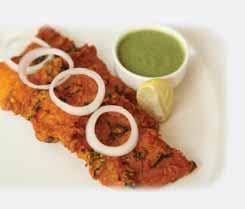

Aloo Gosht
Osama Jalali
Chef, The Mughal Plate By Jalalis
Ingredients
1 kg mutton 500 gm potato 200 gm oil/ghee 5 gm turmeric 10 gm red chili powder 15 gm coriander powder 200 gm brown fried onion 200 gm yoghurt 8 nos cloves 5 gm garam masala 10 gm garlic paste 1 ltr water salt to taste
Method
Heat ghee/oil in a lagan, now add cloves and meat. Sautee it for 2 minutes, then add ginger garlic paste. Leave it for 2 to 3 minutes.
Now add turmeric and red chilli powder, coriander powder and salt according to taste. Sautee it for 5 to 10 minutes and add water and cover it. Leave it for half an hour so that the meat gets tender.
Now add potatoes, brown onions and yoghurt. Add some more water and leave for 15 minutes till the potatoes are cooked. Add the gram masala on top and it is ready to be served. Garnish with fresh coriander.
Ker Sangri

Raj Kumar
Executive chef, Holiday Inn Jaipur City Centre
A delightful indigenous dish of Rajasthan, Ker Sangri is a traditional, spicy sabzi made with ker berry and sangri beans, cooked with common ingredients like red chilies, carom seeds, and a couple of spice powders. The addition of raisins brings out the best in the recipe, as it enhances the flavour of all the spicy ingredients while also providing sweet respites in every spoonful.
Ingredients
75 gm sangri 50 gm ker 70 ml mustard oil 5 gm cumin seeds 2 gm mustard seeds 2 gm red chilli powder 3 gm turmeric powder 10 gm coriander powder salt to taste 50 gm curd 10 gm dry mango powder 10 ml lemon juice 25 gm green coriander leaves
Method
Soak ker and sangri overnight with a little salt and turmeric powder.

Boil soaked ker-sangri and drain the water and keep aside. Make a smooth batter with beaten curd, turmeric, coriander, red chilli and salt in a bowl. Heat oil in a pan, add cumin seeds and mustard seeds, when they begin to crackle add whole dry red chilli then and the curd mixture and cook for 15 mins. Add ker and sangri to the above mixture and cook for another 10 mins. Add lemon juice and dry mango powder. Garnish with chopped coriander and serve hot.

Kashmiri Phirni
Karan Bansal
Senior sous chef Chor Bizarre, Bikaner House
Ingredients
(serves 10 small bowls) 80 gm thick grained suji suji 1 ltr full cream milk 80 gm sugar 0.25 gm saffron 80 gm cashews 100 gm condensed milk milk 20 gm chopped almonds d 5 gm cardamom powder
Method
Clean and soak suji and cashews separately in water. Soak saffron in some warm milk.
Heat milk for a while continuously stirring it to avoid burning at the base. Add soaked suji and cashews after the milk starts to boil. Keep stirring. Add the soaked saffron and sprinkle cardamom powder. Add sugar to the milk when it comes to boil and stir it. Add condensed milk, mix well and reduce it to milk, mix well a pouring consistency. pour Remove from heat. Transfer it into small earthenware bowls and let it cool. Garnish with co saffron and chopped almonds. Serve it cold.
The writer is a lifestyle journalist and author.
Rotary sends girls back to school in Dharwad
Team Rotary News
The adoption of schools by Rotary clubs in RID 3170, especially in the Dharwad region, and providing them with basic amenities such as handwash facility, gender-segregated toilet and giving training to children on personal hygiene will help students to fight the Covid pandemic, said PDG Ganesh G Bhat, member of the Wins National Committee.
Addressing an event to mark International Day of the Girl Child in which 10 girl students who had quit schools due to various reasons were adopted by RCs Dharwad Central and Dharwad Heritage, he sought the help of corporates through their CSR funding to send children back to school. Rotary clubs had provided the amenities and other classroom facilities to government schools which enabled them to reopen despite the pandemic, said Major Siddalingayya, commissioner, Public Education Department of Karnataka government.
Group handwash units with soap, gender-based hygienic toilets, running water and MHM sessions being done by clubs have encouraged parents to send their wards to schools without hesitation, he noted. Psychiatrist Dr Anand Pandurangi said Rotary has a played a key role in changing the mindset of children and parents as schools have reopened with a large number of students attending classes. RC Dharwad Central president Dr Anand Tavargeri, secretary Nagraj, RC Dharwad Heritage president Dr Vani Irkal, secretary Dr Mahabal Shetty and event chair Anand Nayak were present.


AT THE 2022 ROTARY INTERNATIONAL CONVENTION
HOUSTON, TEXAS, USA 4-8 JUNE 2022
Register today at convention.rotary.org


Rotary at a glance
Rotary clubs : 36,994 Rotaract clubs : 10,707 Interact clubs : 16,795 RCCs : 11,875 Rotary members : 1,201,654 Rotaract members: 230,701 Interact members: 386,285
2981 2982 3000 3011 3012 3020 3030 3040 3053 3054 3060 3070 3080 3090 3100 3110 3120 3131 3132 3141 3142 3150 3160 3170 3181 3182 3190 3201 3203 3204 3211 3212 3231 3232 3240 3250 3261 3262 3291
India Total 3220 3271 3272 3281 3282 3292
132 76 137 125 132 77 96 102 69 184 110 124 98 90 105 134 90 140 90 117 104 115 78 138 87 85 160 153 92 62 145 143 98 152 102 107 92 123 168
4,432
76 130 161 308 175 153
5,435
6165 3564 5423 4666 4071 4756 5140 2619 2784 7428 5184 3308 4157 2310 2373 3683 3605 5539 3616 6418 3769 4293 2652 6308 3485 3479 6765 6009 4760 2059 4834 5278 3729 7478 3563 4018 3217 4154 4173
170,832
2396 2217 1963 8329 3957 6053
195,747
Women Rotarians (%)
7.53 7.27 9.13 26.88 27.09 7.30 15.14 14.55 18.03 20.36 14.95 15.63 13.30 5.63 11.21 11.02 16.56 23.74 10.92 27.13 20.75 13.60 8.82 14.90 8.78 9.60 18.34 9.42 7.94 6.41 7.86 12.86 8.64 17.05 15.89 19.91 18.28 14.42 23.27
16.36 17.41 17.07 18.50 11.80 17.26
44 47 90 71 65 30 116 54 33 103 62 42 135 38 10 14 62 108 31 137 79 75 27 83 33 42 156 103 73 19 7 74 28 114 61 63 14 68 133
2,544
87 91 70 264 196 168
3,420
52 98 259 118 76 166 243 81 49 177 70 35 158 64 21 17 31 229 122 182 137 135 20 239 194 124 202 89 233 23 24 204 81 212 405 73 23 72 95
4,833
131 185 22 147 47 128
5,493
236 73 213 36 61 350 363 196 118 563 147 59 115 123 146 106 55 131 166 102 80 118 82 171 115 104 70 63 36 13 134 153 419 99 216 185 44 89 647
6,197
75 25 47 209 47 129
6,729

Rajendra Agarwal Textiles RC Bombay Queen City, RID 3141
Rotary clubs flourish in Mumbai’s housing societies
Three years ago, RC Mumbai Lower Parel was formed in a Mumbai housing society. It set a trend in forming new clubs and driving membership. “Forming Rotary clubs in high-rise buildings, gated communities (GCs) and housing societies was initiated by me to increase membership, and this has become a craze,” says Rajendra Agarwal. He shares this “success formula” of forming vibrant clubs with district governors whenever possible. “Members of such clubs don’t have to step out of their gated premises, or travel a long distance for weekly meetings; and can hold events and programmes there,” he beams.
Agarwal plans to add 10 new clubs and 1,000plus new members taking, their respective numbers to 127 and over 7,000 in the district. In Rotaract, 1,500 new members and 20 new clubs are planned through weekend events/programmes. Over the last five years, Agarwal has coordinated around 3,000 paediatric heart surgeries on children, and plans 1,500 this year. Each surgery costs around `1 lakh, and this is a GG project. Through a mix of GG and member contributions, 25 lakh fruit-bearing saplings will be donated to farmers in Palghar. Over 20,000 cataract surgeries at special camps; fitting of 1,000 Jaipur limbs; and 20,000 bottles of blood are on the cards.
His TRF target is $3 million. Agarwal was introduced to Rotary by Rtn Ajay Goel in 1992. Later on, “I was inspired by PDGs Dr Bal Inamdar and Shrirang Prabhu to climb the ladder of Rotary hierarchy.”
Meet your
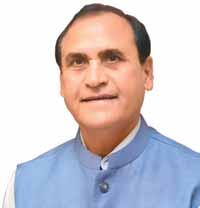

Col Mahendra Mishra Ex-Army officer RC Bhopal Hills, RID 3040
Rotaract gets a booster shot
Aself-motivated Rotarian, this former Army colonel wanted to join a social service organisation “after I retired from the Army in Feb 2009, when one of my colleagues introduced me to Rotary. From then on it has been an exciting journey.” Comprising 23 revenue districts of western MP and two regions of Gujarat, Mishra is giving a big push to Rotaract membership.
“So far, 13 new Rotaract clubs have been formed, five awaiting charter; and this will push up membership to over 2,500 Rotaractors, a 300 per cent growth.” By next June the target for Rotaract is 3040, and for Rotary 3040 from the present 2,649. During the charter presentation for RAC Oriental Indore Navalakha, 646 Rotaractors were inducted. “Many of the newly-installed clubs have more than 100 Rotaractors.”
Five dialysis centres, attached to government and charitable hospitals, are being planned (GG: $175,000). Two ICU on Wheels, a mobile cardiac unit, in Gujarat and Jhabua town, MP, with a GG of $40,000 and 10–15 Happy Schools with CSR funding are being planned. Health check-up, eye-screening, dental and diabetes camps are being held through the year. “We will be holding around 850 medical camps catering to rural families.” His target for TRF giving is around $250,000.
“The challenge of retention is being tackled at all levels, from the top to the club-level. The RI leadership is also supervising the growth of membership in India and club presidents are taking care of this issue,” he says.
Governors
V Muthukumaran

Rajiv Singhal Income tax consultant RC Saket Meerut, RID 3100
“Let us maintain the elite nature of Rotary” A mega Rahat camp at Srinagar in pipeline
As an elite NGO, “Rotary needs to preserve its class and formulate policies to attract quality membership. In recent years, clubs have grown by adapting to rapid changes. The focus must be on inducting new members with intellectual capacity and right attitude to steer our clubs,” says Rajiv Singhal. He plans to charter six new clubs, of which two have been formed, taking the strength to 112 by June next year. Another 300 new members will take the figure to 2,600-plus, he says.
He is aiming to form at least 10 new Rotaract clubs. For the first time, his district will be taking up child heart surgeries in a big way. “I am targeting at least 50 surgeries for children and these will be sponsored by me (about `50 lakh) through private agencies,” says Singhal. Ten Happy Schools will be done at government schools through member contributions.
Another mega project is “gender-specific toilets (50 blocks) in schools which will be funded through a mix of GG ($32,000) and member donations. We have already done 20 such toilet blocks, and the rest will be completed this year.” Singhal has set a target of $41,000 for TRF giving. His father, late Rtn JD Singhal inspired him to join Rotary in 1996. “I became a charter president of RC Saket Meerut. My father is my role model.” Rotary clubs across the NCR, western UP and Uttarakhand have shown “promising growth in the last few years. We need to sustain this ‘special class’ structure and not dilute it. Rotary is for special people,” he says. Education of rural children and environment issues are the priority areas for Dr Upinder Singh Ghai, a laparoscopic surgeon, who is doing at least 4–5 free surgeries each month on patients referred by Rotarians. “I joined Rotary by chance in 1996 when a doctor friend took me to a dinner meeting of clubs. There I met some interesting people. What started as a fellowship turned into service for the community,” says Ghai.
He plans to induct 500 new members, charter 10 new clubs taking their strength to 3,900 and 135 respectively during his tenure. A 3-day RYLA in Manali was attended by 230 Rotaractors including 20 from Nepal. Recently, over 100 women Rotaractors were inducted at the chartering of RAC Sant Singh Sukha Singh College of Commerce for Women, sponsored by RC Amritsar Central. “My target is to add 250–300 new Rotaractors,” says Ghai. Due to terror strikes and bad weather in Srinagar, a 10-day Rahat medical camp in November was postponed. “PDG Rajiv Pradhan is coordinating with RIDs 3141 and 3142 to hold the Rahat camp next year. It will have over 50,000 patients at the OPDs, and perform over 500 surgeries,” he says.
He aims to start three dialysis centres (GG: $35,000–$40,000 each) at private hospitals. “Punjab CM Charanjit Singh Channi is the younger brother of PDG Manmohan Singh, RID 3080, and we are working with the state government to take up at least 10 Happy Schools.” His target for TRF giving is $200,000. His clubs mark all religious festivals by distributing saplings at gurudwaras and temples.
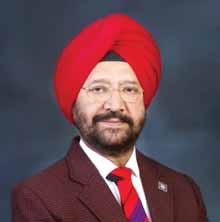
Dr Upinder Singh Ghai Surgeon, RC Jalandhar City, RID 3070






